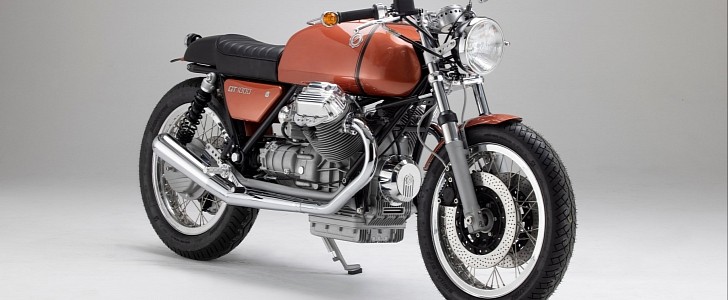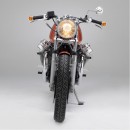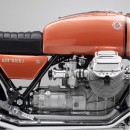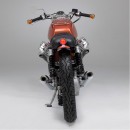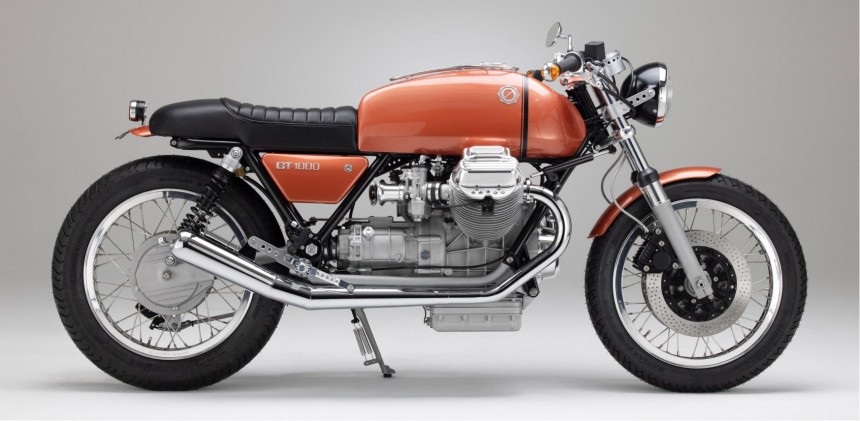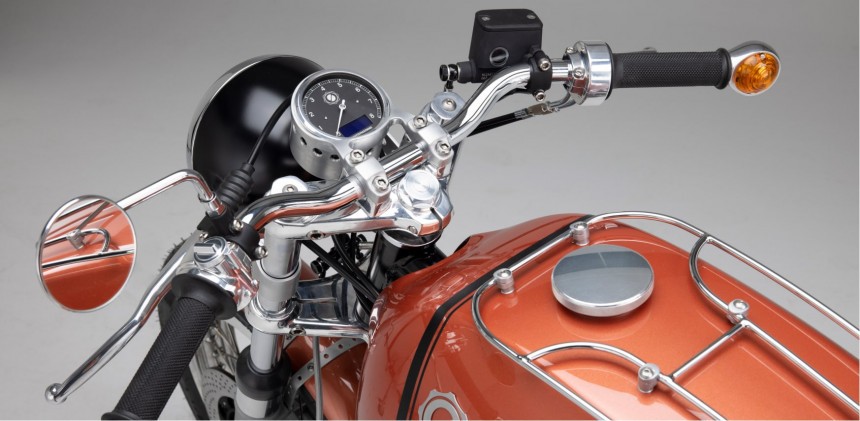Some people will tell you that perfection cannot be attained, but we’re inclined to disagree after seeing this breathtaking stunner.
There are workshops that seek to reinvent their approach on every project they undertake, while others develop a signature style over time and stick to it. Axel Budde’s Kaffeemaschine belongs to the second category, but this doesn’t mean that his firm’s portfolio is repetitive in any way.
On the contrary, these Hamburg-based moto connoisseurs are fully determined to infuse each build with a distinct personality of its own while maintaining a relatively consistent design language across the board. Axel and his crew operate in a sizeable 3,550 square-foot (330 sqm) workspace, where they breathe life into some of the raddest custom motorcycles in existence.
As you might already know, Kaffeemaschine doesn’t aim to be a jack of all trades but a master of one. The firm’s brand of choice has always been Moto Guzzi, with donors like the iconic Le Mans III and 850 T being their favorite platforms to work on. However, the bike we’re about to inspect isn’t based on either of these candidates.
In its previous life, this classy piece of machinery was a bone-stock 850 T3 developed for the 1980 model-year. The very first iteration of Guzzi’s nameplate debuted in 1975 when the House of Mandello del Lario deemed it necessary to equip the esteemed 850 T with triple disc brakes.
The T3 retained its predecessor’s air-cooled 844cc V-twin engine, which is good for up to 68 horses and 54 pound-feet (73 Nm) of torque – in stock form, that is. We say this because no stone has been left unturned following Kaffeemaschine’s makeover, so the beast pictured above is now a zestful liter-bike with 85 fierce stallions on tap!
With that being said, let’s see how the Germans managed to achieve these digits, shall we? For starters, the donor’s twin-cylinder mill got treated to a multitude of higher-spec components, including an aftermarket crankshaft, larger valves, and a state-of-the-art cam, as well as an electronic ignition setup and a top-shelf flywheel.
The cylinders were massaged to accommodate new pistons, thus boosting the titan's displacement to 1,000cc. An enlarged capacity will always demand amplified airflow, so Axel’s specialists promptly installed a unique two-into-two exhaust system and Dell’Orto PHF carburetors.
To wrap things up in the powertrain sector, the team proceeded to freshen up the predator’s driveshaft and five-speed gearbox, while its standard battery has been replaced with a lithium-ion module for good measure. Moving on to the chassis, Kaffeemaschine upgraded the T3’s brakes using a Le Mans’ repurposed rotors, all of which are mated to overhauled Brembo calipers.
As far as the Guzzi’s suspension is concerned, its forks were thoroughly refurbished from head to toe, and they’re joined by Wilbers shock absorbers at the opposite end. You will find a set of stainless-steel spokes linking the machine’s wheel hubs to Morad rims, measuring 18 inches up north and 17 inches down south.
In typical Kaffeemaschine fashion, the stock bodywork was ditched in its entirety, making room for a complete carbon fiber outfit. It consists of a slim front fender and a massive fuel tank resembling that of a Laverda SF, but what you’re seeing underneath the saddle aren’t side panels. A closer inspection will reveal that Budde’s pros fitted a bespoke storage compartment right below the bike’s new seat.
Finally, we arrive at the cockpit, where you’ll be greeted by a custom-made speedometer and a chromed handlebar. The latter features a single mirror, heated grips, and fresh switches, along with a pair of bar-end turn signals that remind us about the Hella blinkers found on some classic BMWs. To round it all out, Kaffeemaschine’s craftsmen enveloped the superstar's attire in a glossy layer of bronze paint.
On the contrary, these Hamburg-based moto connoisseurs are fully determined to infuse each build with a distinct personality of its own while maintaining a relatively consistent design language across the board. Axel and his crew operate in a sizeable 3,550 square-foot (330 sqm) workspace, where they breathe life into some of the raddest custom motorcycles in existence.
As you might already know, Kaffeemaschine doesn’t aim to be a jack of all trades but a master of one. The firm’s brand of choice has always been Moto Guzzi, with donors like the iconic Le Mans III and 850 T being their favorite platforms to work on. However, the bike we’re about to inspect isn’t based on either of these candidates.
In its previous life, this classy piece of machinery was a bone-stock 850 T3 developed for the 1980 model-year. The very first iteration of Guzzi’s nameplate debuted in 1975 when the House of Mandello del Lario deemed it necessary to equip the esteemed 850 T with triple disc brakes.
With that being said, let’s see how the Germans managed to achieve these digits, shall we? For starters, the donor’s twin-cylinder mill got treated to a multitude of higher-spec components, including an aftermarket crankshaft, larger valves, and a state-of-the-art cam, as well as an electronic ignition setup and a top-shelf flywheel.
The cylinders were massaged to accommodate new pistons, thus boosting the titan's displacement to 1,000cc. An enlarged capacity will always demand amplified airflow, so Axel’s specialists promptly installed a unique two-into-two exhaust system and Dell’Orto PHF carburetors.
As far as the Guzzi’s suspension is concerned, its forks were thoroughly refurbished from head to toe, and they’re joined by Wilbers shock absorbers at the opposite end. You will find a set of stainless-steel spokes linking the machine’s wheel hubs to Morad rims, measuring 18 inches up north and 17 inches down south.
In typical Kaffeemaschine fashion, the stock bodywork was ditched in its entirety, making room for a complete carbon fiber outfit. It consists of a slim front fender and a massive fuel tank resembling that of a Laverda SF, but what you’re seeing underneath the saddle aren’t side panels. A closer inspection will reveal that Budde’s pros fitted a bespoke storage compartment right below the bike’s new seat.
Finally, we arrive at the cockpit, where you’ll be greeted by a custom-made speedometer and a chromed handlebar. The latter features a single mirror, heated grips, and fresh switches, along with a pair of bar-end turn signals that remind us about the Hella blinkers found on some classic BMWs. To round it all out, Kaffeemaschine’s craftsmen enveloped the superstar's attire in a glossy layer of bronze paint.
